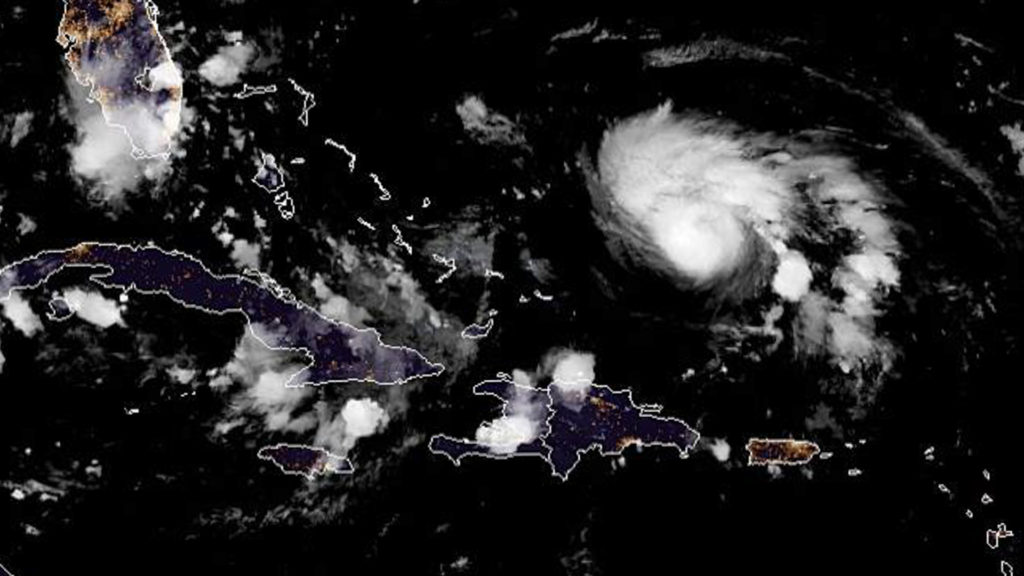Dorian Surging in Strength, Track Shifts Closer to South Florida
Tony WintonAugust 29, 2019

In this enhanced satellite image with graphics from NOAA, Hurricane Dorian is shown north of Puerto Rico, Aug. 29, 2019. Forecasters say it will become a an extremely dangerous Cateogy 4 as it approaches Florida (NOAA via Key News)
Hurricane Dorian started getting stronger overnight, with winds of 110 miles per hour and a forecast track making it more likely that Key Biscayne and the rest of South Florida would feel its effects. In Key Biscayne, the Village announced plans to start handing out sandbags starting at 10 a.m at the beach club. Details are here.
At the same time, forecasters say the forward progress of the storm has slowed a bit.
“Dorian should move over the Atlantic well east of the southeastern and central Bahamas today, approach
the northwestern Bahamas Saturday, and move near or over portions of the northwestern Bahamas on Sunday,” the National Hurricane Center said in an 8 a.m. Friday update
Hurricane Watches have been posted for the Northwestern Bahamas.
Village officials have been readying plans for an emergency declaration if Miami-Dade County Mayor Carlos Gimenez acts. It is Gimenez’ decision on whether to order an evacuation of the island.
Forecasters at the National Hurricane Center said NOAA and Air Force reconnaissance planes found the hurricane’s central pressure was dropping and that size of the storm was widening.
Still, differing computer models made it hard for forecasters to express confidence in the path. They said the size and the timing of steering currents from an area of high pressure are hard to predict.
“As you can imagine, with so many complex variables in play, it is no wonder the models have been having a difficult time nailing down the path of the hurricane. There’s been a notable trend on this model cycle toward a slower, more westward track,” said Hurricane Specialist Eric Blake.
The Hurricane Center said there is a 82% chance of at least tropical-storm force winds hitting Miami. The chance of hurricane-force winds was put at 30%.
Along the coast, residents picked the shelves clean of bottled water and lined up at gas stations Thursday as an increasingly menacing-looking hurricane threatened to broadside the state over Labor Day weekend.
President Donald Trump canceled his weekend trip to Poland and warned Florida residents to be prepared.
“All indications are it’s going to hit very hard and it’s going to be very big,” Trump said in a video he tweeted Thursday evening, comparing Dorian to Hurricane Andrew, which devastated South Florida in 1992.
With the storm’s track still unclear, no immediate mass evacuations were ordered.

In this graphic from the National Hurricane Center, Dorian’s forecast track is shown as of 5 a.m. Friday, Aug 30 (National Hurricane Center via Key News)
Along Florida’s east coast, local governments began distributing sandbags, shoppers rushed to stock up on food, plywood and other emergency supplies at supermarkets and hardware stores, and motorists topped off their tanks and filled gasoline cans. Some fuel shortages were reported in the Cape Canaveral area.
Josefine Larrauri, a retired translator, went to a Publix supermarket in Miami only to find empty shelves in the water section and store employees unsure of when more cases would arrive.
“I feel helpless because the whole coast is threatened,” she said. “What’s the use of going all the way to Georgia if it can land there?”
Tiffany Miranda of Miami Springs waited well over 30 minutes in line at BJ’s Wholesale Club in Hialeah to buy hurricane supplies. Some 50 vehicles were bumper-to-bumper, waiting to fill up at the store’s 12 gas pumps.
“You never know with these hurricanes. It could be good, it could be bad. You just have to be prepared,” she said.
Florida Gov. Ron DeSantis declared a state of emergency, clearing the way to bring in more fuel and call out the National Guard if necessary, and Georgia’s governor followed suit.
Royal Caribbean, Carnival and Norwegian began rerouting their cruise ships. Major airlines began allowing travelers to change their reservations without a fee.
At the Kennedy Space Center at Cape Canaveral, NASA decided to move indoors the mobile launch platform for its new mega rocket under development.
A Rolling Stones concert Saturday at the Hard Rock Stadium near Miami was moved up to Friday night.
The hurricane season typically peaks between mid-August and late October. One of the most powerful storms ever to hit the U.S. was on Labor Day 1935. The unnamed Category 5 hurricane crashed ashore along Florida’s Gulf Coast on Sept. 2. It was blamed for over 400 deaths.
The Associated Press contributed to this report.


